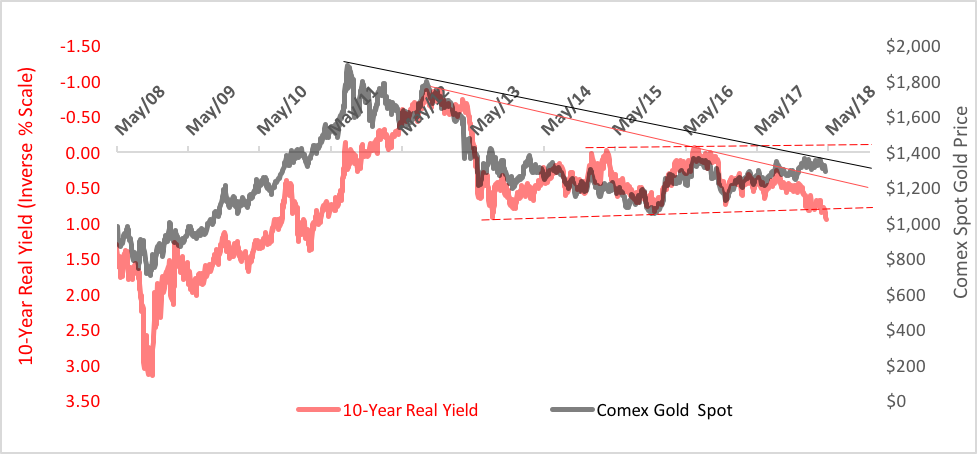There’s a story that’s often told by gold aficionados to illustrate the metal’s utility as a medium of exchange. An ounce of gold, it’s said, will buy a man’s suiting today just as it would in ancient Rome. The underlying thesis? Gold is a repository of value and therefore is an antidote to monetary inflation.
Many folks take that to mean gold can be used willy-nilly as an inflation hedge. Or, worse, that gold should be bought speculatively in anticipation hikes in the Consumer Price Index. Not so. Oh, for the long run—say, millennia—gold can hedge currency depredation, but over shorter investment horizons, often not. We touched on gold’s correlation to CPI back in March.
Last week, gold broke below $1,300 for the first time this year against a backdrop of rising rates on the long end of the yield curve. The rate spike has been blamed by many market observers and pundits for bullion’s breakdown. But that’s just part of the story. Yes, rates moved higher but inflation—and inflationary expectations—ticked up as well. You can see the gold/inflation conundrum, can’t you?
I mean, inflation rose but gold declined.
Don’t get me wrong. There is a relationship between gold and inflation, but it’s traced through real yields. Real yields represent an investor’s payout after inflation. There’s a high degree of fit between gold prices and real yields as you can see in chart below.

Actually, the relationship is inverse: as real yields decline, gold tends to appreciate; gold sinks when real yields spike.
It seems if we knew where real rates were headed, we might know when it’s advantageous to buy or sell gold. So what drives real yields? Just this: when nominal yields on Treasury notes rise faster than inflationary expectations, real rates rise; real rates fall when inflationary expectations run ahead of T-note rates.
That bearish diversion between gold prices and real rates we noted in March finally paid off last week. Real yields broke out of a channel established in 2015, dragging gold through a stack of sell stops.
Technically, gold has weakened substantially. The downside breakthrough of its 200-day moving average puts a bearish objective of $1,216 in view.
This should remind investors that gold isn’t so much an inflation hedge; it’s really a real rate hedge. That said, speculative buyers need to ask themselves if they believe inflationary expectations are likely to outrun nominal yields. If not, perhaps a purchase should be put off.
Brad Zigler is WealthManagement’s Alternative Investments Editor. Previously, he was the head of Marketing, Research and Education for the Pacific Exchange’s (now NYSE Arca) option market and the iShares complex of exchange traded funds.





